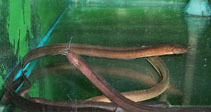| Family: |
Clariidae (Airbreathing catfishes) |
| Max. size: |
41.6 cm TL (male/unsexed) |
| Environment: |
benthopelagic; freshwater; pH range: 6.5 - 7.80000019073486; dH range: 25, |
| Distribution: |
Africa: Kouilou basin (Congo Republic) to Loge River basin (Angola), including the lower, middle and upper Congo River basin (Congo Republic, Democratic Republic of the Congo and Angola) (Ref. 58526, 81644, 106245). |
| Diagnosis: |
Dorsal spines (total): -0; Dorsal soft rays (total): 105; Anal spines: -0; Anal soft rays: 118; Vertebrae: 76-117. Diagnosis: small supraorbital process on infraorbital IV, not reaching the rostral border of the eye; fenestra between scapulo-coracoid and cleithrum absent; interdigitation between entopterygoid and quadrate (Ref. 81644).
Description: body extremely elongate, abdominal depth 2.5-9.6% SL (mean 5.0); long dorsal and anal fins, continuous with caudal fin; distance between supraoccipital process and dorsal fin 4.6-20% SL (mean 9.2); pectoral fins present or absent, when present, length between 2.4-39.9% of skull length; pelvic fins absent in most cases, however, several specimens have both or a single pelvic fin, with length 15.8-30.6% skull length (mean 24.5); skull short, 4.8-17.8% SL (mean 9.7); skull roof (exposed bony part in between bulging jaw muscles) narrow, 10.7-35.3% (mean 21.6) skull length; jaw muscles hypertrophied but may or may not bulge (generally bulging in larger specimens); eyes bordered by small infraorbital bones, of which postorbital one has a plate-like outgrowth; internal mandibular barbel always shorter than skull, other barbels longer; maxillary barbel longest (55-151% HL, m = 93); eyes small, without free orbital rim (Ref. 81644).
Coloration: body uniformly dark to pale brown, paler ventrally or fades from dark to pale (e.g. specimens from Congo basin); unpaired fins coloured as body, paired fins usually paler (Ref. 81644). |
| Biology: |
Prefers forest streams and swamps, where it lurks among the roots of trees and may even capture its prey on land. Also found in rapids (Ref. 78218). Channallabes apus is an omnivore (Ref. 78218). |
| IUCN Red List Status: |
Least Concern (LC); Date assessed: 01 May 2009 Ref. (130435)
|
| Threat to humans: |
harmless |
Source and more info: www.fishbase.org. For personal, classroom, and other internal use only. Not for publication.
